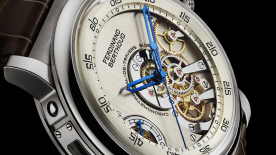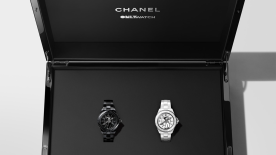There is no point searching for a historical collection from which the creators of this 2016 new release might have drawn inspiration, since a 1940 one-of-a-kind wristwatch in the Patek Philippe Museum is the only known piece combining these two complications that are now united in the World Time Chronograph 5930 which is joining the Complications line. It perfectly embodies the symbiosis of two skills for which Patek Philippe is particularly renowned, which are much coveted by collectors and should destine this Haute Horlogerie model to a brilliant future. The entire GMT team is extremely proud to feature this exceptional watch on the magazine cover.

Patek Philippe’s acknowledged experience and track record in each of these mechanical disciplines notwithstanding, this historical expertise in no way guaranteed that the two horological complications could be associated and interlocked in such a way as to meet the extremely demanding criteria of the Patek Philippe Seal. 21st century technical standards are high, the mechanisms are more complex than ever, and both the chronograph and World Time are by definition the kind of complications that call for considerable space for the numerous indications. 24 time zones and as many cities for the former; and counters as well as a central sweep-seconds hand for the latter.
"The rigorous nature of the tests required to combine these two complications is reflected in the pleasing aesthetics and reliable long-term precision."
Months of research and development, along with stringent testing, were required to twin them with rigorous precision, while ensuring this alliance is compatible with Patek Philippe’s ongoing quest for aesthetic and technical perfection. This ambitious approach gave rise to a new mechanical movement, adjusted to the nearest hundredth of a millimeter to ensure enduring reliability.
While Caliber CH 28-520 HU is indeed based on the self-winding CH-28- 520 PS chronograph caliber with column-wheel control and a vertical clutch, as well as the famous World Time module that was optimized to include two important refinements patented in 1959 and 1999, the mechanism has been entirely adapted. Axes were shifted, bridges thinned and newly designed, and component clearances changed so that the mechanisms could be smoothly recombined. Thanks to the vertical clutch, the chronograph hand can also serve as a permanently running seconds hand with a minimum of wear and without negatively influencing the rate accuracy and power reserve of the watch.

Simplicity serving complexity
A complex watch is a real success when it is truly user friendly. The two functions of this World Time self-winding chronograph are indeed extremely easy to handle. The central hours and minutes indicate the time in the city and time zone whose name is shown at 12 o’clock. The time in the 23 other zones can be read off at a glance with the city disk and the 24-hour ring located nearer the center. The division of the latter into blue and white zones indicates whether it is day or night in the given location. Patek Philippe has also updated the city scale on which some time zones are defined by new place names – such as Dubai which replaces Riyadh and Buenos Aires that takes over from Rio – while others have undergone a change in local time, such as Moscow which has switched from UTC+4 to UTC+3.
When the traveler arrives in a new time zone, all he needs to do is to press the corrector button at 10 o’clock. The city disk and the 24-hour ring advance counterclockwise in one-hour steps, while the central hand moves clockwise, also in one-hour jumps. The correction is completed when the city name of the destination time zone is at 12 o’clock. During this process, the World Time mechanism and the hours hand are uncoupled from the base movement so that neither the amplitude of the balance nor the precision of the minutes hand are affected. The chronograph hand keeps moving without the slightest irregularity. The latter is operated via a start/stop pusher at 2 o’clock and a reset pusher at 4 o’clock that also doubles as a flyback pusher. When it is pressed while the chronograph is running, the chronograph hand flies hand flies back to zero and a new time measurement begins. The seconds scale for chronograph measurements appears between the city disk and the 24-hour ring, in the form of a narrow white circular scale with ultra-precise fourth-of-a-second graduations, thus enabling measurements accurate to the nearest eighth of a second.
Tradition without borders
The show continues on the back, in a notably dynamic way on the oscillating weight decorated with circular “Côtes de Genève” and an engraved Calatrava cross, while the center of the rotor is finely circular-grained. More “static” yet creating infinitely shimmering reflections, the circular graining is repeated on the rhodiumed bridges with polished chamfers and countersinks, along with gilt engraving in compliance with the Patek Philippe Seal criteria. These elements make a fine contrast with the gleaming red bearing jewels, the golden hue of the Gyromax® balance and the purple-blue shimmer of the patented Spiromax® balance spring in Silinvar®. Thanks to its Patek Philippe terminal curve, this balance spring combines the concentric breathing of a Breguet hairspring with the slim build of a classic flat balance spring. The movement is neatly fitted into a classic round case in 18K white gold. It’s winglet-style strap lugs echo a characteristic detail of the 1940s and 1950s World Time watches. Finally, the time-zone correction button, unsurprisingly positioned at 10 o’clock, features a rectangular time-zone corrector button identical to that of the two chronograph pushers. Their shape is a current theme on the classic chronographs from the Manufacture. The result is a chronograph on which the sun never sets thanks to its 24 time zones ; and who would not wish for such a marvel to grace a personal collection and be passed on to future generations ?

World Time Chronograph Reference 5930
CASE : 18K white gold, sapphire crystal caseback, water-resistant to 30m
DIAMETER : 39.5mm
MOVEMENT: mechanical self-winding (Caliber CH 28-520 HU, 50h power reserve), 343 parts, column-wheel chronograph, vertical clutch, central rotor in 21K gold, unidirectional winding
FUNCTIONS : hours, minutes, seconds, chronograph, day/night indication, 24 time zones
DIAL : three zones, handguilloché navy blue center, applied batontype hour-markers in 18K white gold hour-markers and Dauphine-time hours and minutes hands
STRAP : hand-stitched alligator with large square scales, matt navy blue with folding clasp in 18K white gold
_____________________________________________________________________
Let’s make one thing clear from the start : the new World Time reference 5230 replaces all the previous World Time models from Patek Philippe, which has now adopted the latest norms in the realm of time zones. As we saw on the previous page, Moscow time has shifted closer to Western Europe by moving to UTC+3 instead of UTC+4, while Dubai has replaced Riyadh, and Buenos Aires has taken over from Rio. The times and locations appearing on this 2016 World Time comply with the latest standards.

On the other hand, this approach did not prevent the design department, guided by the family owners of the Manufacture, to draw from the past certain decorative details and techniques that tend to have been forgotten by other brands. Patek Philippe collectors will thus perhaps recognize the fine guillochéd basket weave motif inspired by a precious pocket watch from the Patek Philippe Museum, on which the pattern was originally coated with a translucent blue enamel using the flinqué technique.
The Manufacture still masters these nearly extinct handcrafts because it has faithfully preserved the skills required within its workshops and passing them on from generation to generation. It has also kept the indispensable tools such as the “tour à flinquer” an almost century-old manually operated rose engine used to create the guilloché dial pattern: a machine meticulously serviced and that works as reliably today as when it was first commissioned.
"Fine craftsmanship, ancestral techniques and patented technologies bring the best of the watchmaking world and the hours of the whole world to the wrist."
Since respect for traditions is naturally not incompatible with contemporary design, the reference 5230 is distinguished from previous World Time models by a set of subtle changes, such as the winglet-style lugs and the narrow, smoothly polished bezel. In a similar way, the pierced hand inspired by the famous “Southern Cross” constellation replaces the former ringed hours hand, while the minutes hand featuring a lozenge-shaped cut-out relegates the Dauphine version that long adorned World Time models to the status of collector’s item. The two gold hands both feature a sharp central ridge set between two meticulously lapped, beveled flanks.
Useful function, user-friendly handling
Above and beyond technical prowess and aesthetic mastery, the value of a timepiece is also measured by its smooth handling and the practical role it serves. It is good to be able to check at a glance the time in places where business contacts or friends and family live, or to adjust a watch in a few simple presses to the time zone where a traveler has just landed. The dial center hour hand logically indicates local time in the zone whose assigned city name appears at 12 o’clock. The local times in the 23 other time zones are read off on the 24-hour disk that rotates counterclockwise inside the city disk. The minutes as indicated by the dedicated hand are the same for all time zones.
In the same way, when the user arrives in another time zone, he only needs to press the pusher at 10 o’clock as many times as needed to align the respective city name at 12 o’clock. Each time the pusher is pressed, the hours hand advances by one hour, while the city disk and the 24-hour ring will move by one hour increments in the counterclockwise direction. Patek Philippe engineers have succeeded in uncoupling the World Time mechanism from the base movement so as to ensure that the local time zone change that does not disturb the minutes hand or the amplitude of the balance.

A caliber perpetually improved over the past 40 years
While Patek Philippe’s expertise in the domain of World Time goes back almost 80 years, it currently beats to the rhythm of the legendary Caliber 240 which was built and patented in 1977. This ultra-thin micro-rotor self-winding movement developed by the Manufacture Patek Philippe has made its mark on watchmaking history. Despite the addition of the sophisticated time-zone mechanism on an automatic winding mechanism that would normally imply a thicker housing, this movement measures a mere 3.88mm thick and thereby fits smoothly inside the slim and elegant lines of the Calatrava case. It owes this to the patented integration of the micro-rotor on the bridge level, with its small diameter compensated by the fact that it is made in solid 22K gold, thereby increasing its mass, its torque and hence its winding performance.
In addition, this miniature mechanical marvel has been constantly optimized since 1977 and is now distinguished by a patented Spiromax® balance spring made from a silicon derivative named Silinvar®. This ensures a high degree of accuracy exceeding customary timekeeping standards and complying – like all the other movement characteristics – with the Patek Philippe Seal requirements. The bridges are chamfered and adorned with “Côtes de Genève”. The gold mini-rotor also bears the same Geneva striping, along with an engraved Calatrava cross, the emblem of the Manufacture. The baseplate is circular-grained by hand and the gilt brass wheel spokes are countersunk and chamfered. Such superlative refinement on both sides of the case is truly exceptional, from one end of the earth to the other.
World Time Reference 5230
CASE : 18K white or 5N rose gold, sapphire crystal case back, water-resistant to 30 meters
DIAMETER : 38.5mm
MOVEMENT : mechanical self-winding (Caliber 240 HU, 48h power reserve), 239 parts, 22K gold microrotor, Patek Philippe Seal decorations
FUNCTIONS : hours, minutes, 24 time zones, day/night
DIAL : three zones, handguilloché center with basket weave pattern
STRAP : hand-stitched alligator with large square scales, shiny black or chocolate brown with Calatrava folding clasp in 18K white or rose gold.




